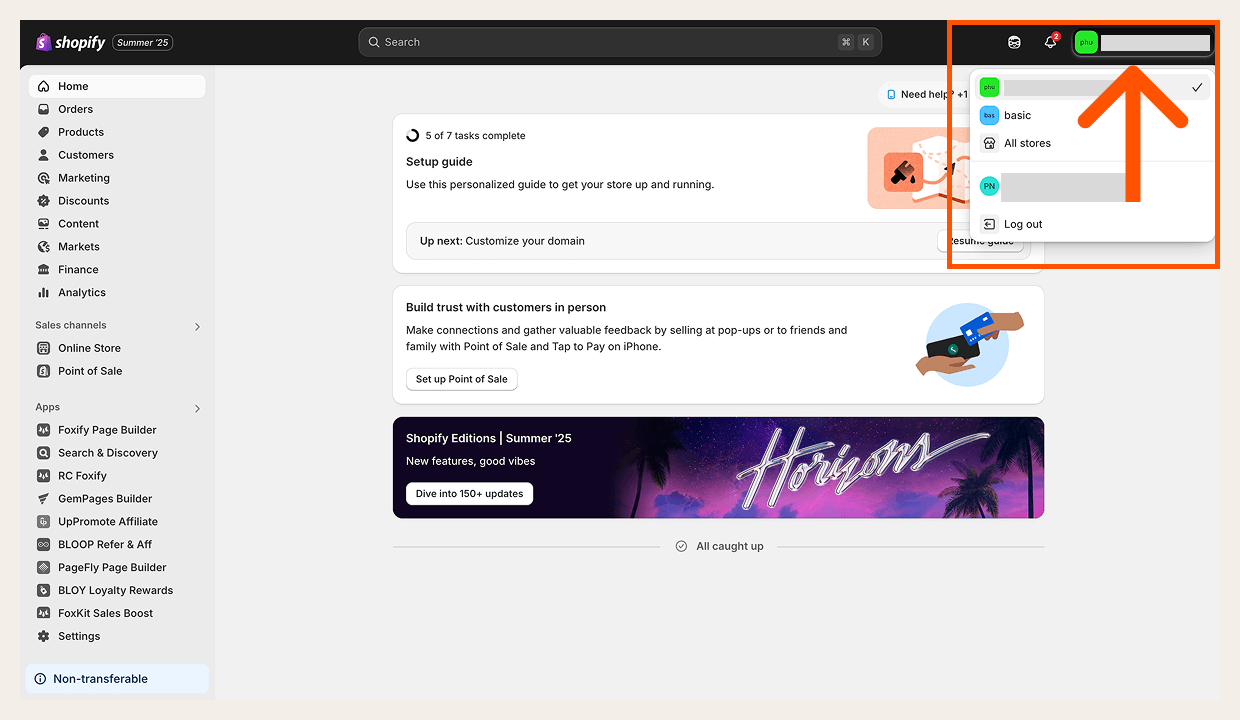Are you considering how to have multiple stores on Shopify and wondering why it might be the right choice for your business? Having multiple Shopify stores lets you:
- reach different customers,
- sell different products,
- or expand your business to new regions easily
Whether you want to create separate stores for different brands or markets, managing multiple stores can help you stay organized and grow faster.
In this article, I’ll explain what Shopify multiple stores are, when to use them, and share tips on how to manage them well. If you want to learn more about growing your Shopify business, check out our FoxEcom blog.
Shopify Multiple Storefronts vs. Multiple Stores: What’s the Difference?
While the terms may sound similar, they represent distinct strategies with different setups, purposes, and implications. Below, I’ll explain each term, provide a comparison table, and illustrate with a real-world example.
What are multiple Shopify stores?
Multiple Shopify stores mean you’re running completely separate Shopify accounts. Each store has its own:
- Domain
- Product catalog
- Inventory
- Customer database
- Admin dashboard
Each store functions independently and requires its own subscription (Basic, Shopify, Advanced, or Plus).
When to Use:
Choose this setup if you are managing entirely different brands, legal entities, or product lines with minimal overlap. It’s also suitable if you’re not on the Shopify Plus plan and still want regional or brand-specific stores.
Example:
You sell vegan skincare in the US and want to expand to the UK. You create two separate stores:
- veganskincare.us for the US
- veganskincare.uk for the UK
Each store has its own pricing, tax rules, local team, and product packaging.
Whether you want to create separate stores for different brands or markets, managing multiple stores can help you stay organized and grow faster. To get inspired, check out some of the best Shopify stores we’ve curated.
What are Shopify multiple storefronts?
Multiple storefronts are a Shopify Plus feature that lets you create up to 10 separate stores (1 primary + 9 expansion stores) under the same organization. While each storefront is technically a separate store with its own admin, Shopify Plus gives you centralized control over users, billing, and theme/product transfers.
Each storefront can have its own:
- Domain
- Language and currency
- Product selection and theme
- Checkout settings
However, data like inventory, orders, and customers is not shared between storefronts by default - you'll need apps or APIs to sync them.
When to use:
- Use this setup if you’re on Shopify Plus and want to:
- Expand into new countries with localized experiences
- Create specialized stores (e.g., B2B vs. DTC, or employee-only stores)
- Manage multiple brands or product lines within one organization
- Control billing and staff access from a single place
Expansion store use cases:
- International stores: Same brand and products in different regions/languages/currencies
- Product line extensions: Different catalogs under the same brand umbrella
- Wholesale/B2B portals: Restricted pricing and login-only access for partners
- Employee or VIP stores: Internal or invite-only storefronts
- Retail-only stores: Physical retail locations with separate POS-focused catalogs
Example:
You sell fitness gear globally. With Shopify Plus, you create:
- fitgear.com (US store, English, USD)
- fitgear.fr (France store, French, Euro)
- fitgear.jp (Japan store, Japanese, Yen)
Each storefront is tailored for the local audience but managed within the same Shopify Plus organization.
Tips: Keep your storefronts beautifully consistent
Shopify Plus allows you to share themes between stores, so your brand stays visually cohesive across markets.
If you’re launching a new storefront for B2B or simply want to elevate your customer experience, check out our two most recommended themes:
Sleek – Perfect for modern D2C brands

Sleek Shopify theme
A mobile-first, high-converting theme that gives you full creative control. With built-in conversion blocks, sleek animations, and performance-first design, Sleek helps D2C brands scale fast while keeping customers engaged.
👉 Ideal for: lifestyle, beauty, wellness, fashion, and consumer tech brands.
“I recently used the Sleek Shopify theme for one of my D2C brand projects, and overall, it’s been a great experience. The design is clean and modern, which really helps products stand out without feeling cluttered. It’s easy to customize — even without deep coding skills — and everything from homepage sections to product pages feels well thought out.”
Aroma-labs-com | Jul 14, 2025
Hyper – Built for bold scaling

Hyper Shopify theme
Designed for high-growth businesses and hybrid models (D2C + B2B), Hyper combines performance with advanced customization options. Whether you're creating a gated wholesale storefront or launching a VIP-only portal, Hyper’s flexible architecture helps you deliver unique shopping experiences at scale.
👉 Ideal for: furniture, tech, gear, fitness, and high-volume merchants.
“The Hyper theme is clean, fast, and super modern. It’s great if you want a bold, edgy look for your store. Easy to customize, works well on mobile, and the animations make it feel really dynamic. The customer support has been helpful and quick to respond.”
Funside.it | Jul 18, 2025
Comparison table: Shopify multiple storefronts vs. multiple Shopify stores
|
Aspect |
Multiple Shopify Stores |
Multiple Shopify Storefronts (Plus) |
|
Definition |
Separate Shopify accounts, each with its own backend |
Separate storefronts under one Plus account, but with individual setups |
|
Plan requirement |
Any Shopify plan (Basic, Shopify, Advanced, Plus) |
Requires Shopify Plus (~$2,300/month) |
|
Number of stores |
Unlimited (with separate subscriptions) |
Up to 10 storefronts (1 main + 9 expansions) under 1 Plus contract |
|
Admin access |
Separate admin dashboards and logins |
Centralized organization admin with access to all storefronts |
|
Data sharing |
No data sharing by default |
No data sharing by default (manual or app-based syncing required) |
|
Inventory management |
Separate; syncing requires apps |
Separate; syncing requires apps |
|
Order management |
Orders are handled individually per store |
Orders handled individually unless integrated |
|
Branding flexibility |
Complete; each store is unique |
High; different themes, catalogs, and domains possible per storefront |
|
Customer data |
Managed separately per store |
Managed separately per storefront |
|
SEO control |
Managed per store independently |
Central strategy possible; support for international SEO best practices |
|
Biling |
Each store is billed separately |
One centralized Plus contract |
|
Staff management |
Staff roles are set individually per store |
Central staff and permission control at the organization level |
|
Cost efficiency |
More affordable for smaller brands, but grows in cost with scale |
Higher upfront cost, but more scalable with fewer admin inefficiencies |
|
Use case |
Separate brands or legal entities |
Regional expansion, B2B/DTC split, localized experiences |
|
Complexity |
Higher (data silos, integrations needed) |
Medium (centralized control, but multiple configs to manage) |
Key considerations:
- Choose Multiple Stores if: You run distinct brands or product lines with little overlap, need separate legal entities (e.g., for tax compliance), or are on a lower-tier Shopify plan (non-Plus). This approach suits smaller businesses or those with diverse offerings.
- Choose Multiple Storefronts if: You’re on Shopify Plus and want to target different regions, languages, or customer segments with tailored experiences while keeping operations centralized. This is ideal for scaling global businesses.
Okay, now that we’ve clarified the difference between multiple Shopify stores and multiple Shopify storefronts, let’s answer some of the most common questions people ask.
1. How many Shopify stores can I have?
There’s no hard limit - you can create as many Shopify stores as you want. But it depends on how you structure them:
- Multiple stores across different accounts/one account: You can sign up for multiple Shopify plans (Basic, Shopify, Advanced, or even Plus) using the same or different email addresses. This is the most common setup for brands operating completely separate businesses or regional stores.
- Multiple storefronts under one account: This is only available with Shopify Plus. You can add up to 9 additional storefronts under a single Plus account, giving you 10 stores total, all sharing the same backend/admin for streamlined management.
2. Can you make multiple stores on one account?
Yes, you can. For if you are on Basic, Grow, or Advance, you can have multiple stores under the same account. But each store works separately, and you need to pay for the subscription to each store. Otherwise, you can choose
3. Can you create Shopify Plus multiple stores?
Yes, that’s actually one of the key benefits of Shopify Plus. You get one main store, and you can add up to nine additional stores under the same license. These can be used for different regions (like US, UK, EU), languages, currencies, or business models (like B2B and D2C).
How to Create Multiple Shopify Stores? (For Shopify & Shopify Plus)
How to create multiple Shopify Basic/Growth/Advance Stores?
You can create as many stores as you want, but each one needs a separate subscription. In this case, we will create another stop under the same email account. Just follow these steps:
Step 1: Click the store icon in the top-right corner of your Shopify admin (next to the notification bell), then select All stores.

Step 2: Click Create store.

Step 3: Go through the onboarding questions. These help Shopify personalize your experience. You can skip them if you want.

Step 4: In the new store admin, start setting things up:
- Add your Shopify store name
- Upload products
- Customize your storefront
- Set up payment methods
- And more!
That’s it - you now have a new Shopify store up and running.

How to create Shopify Plus multiple stores?
Shopify Plus makes managing multiple stores even easier. With a Plus plan, you get nine extra expansion stores at no additional cost.
Here’s how to create them:
Step 1: In your Shopify Organization Admin, go to Stores, then click Create store.

Step 2: Choose your store type (standard, expansion, sandbox, etc.), then fill in your store details. You can also choose to import data from an existing store here.
Step 3: Click Create store - and you’re done!

Once your new Plus store is live, you can:
- Add and customize your theme
- Integrate essential Shopify Plus apps
- Assign staff roles with specific permissions
- Set up advanced automation and checkout customization
With Shopify Plus, managing multiple brands, markets, or regions becomes much more streamlined.
At this stage, many merchants ask: “Should I duplicate my store or build from scratch when launching multiple Shopify stores?”
In most cases, duplicating your store is the smarter move - especially if the new store shares similar branding, layout, or products. It saves time by carrying over theme settings and design assets, helping you launch faster while maintaining conversion-optimized elements.
However, build from scratch if the store targets a new audience, offers a different product line, or represents a distinct brand with its own structure.
My advice:
- Duplicate for regional expansion or brand consistency.
- Start fresh for new business models or standalone brands.
If you need to transfer data from this store to another, or keep data synchronized between multiple stores, here are two tools we recommend: Matrixify and LitExtension.
- Matrixify: Ideal for bulk data import/export and ongoing store data management. It supports a wide range of data types, from products and customers to metafields and redirects.
- LitExtension: Best for complete store migration. It helps you transfer products, orders, customers, and more from one platform to another with minimal downtime and no technical skills required.
How to Manage Your Multiple Shopify Stores to Their Peak?
Running multiple stores in Shopify helps you grow, but managing everything separately can be overwhelming. Here are best practices for managing multiple Shopify stores to simplify your operations and stay in control.
1. Keep the storefront design consistent
Consistency builds trust and reinforces your brand identity across regions or customer segments. If your stores look disjointed, your brand feels fragmented.
💡 Try these themes/apps to ensure design harmony and save time:
- Foxify – Smart Page Builder: Build any page types. Start building from 100+ high-converting templates. Use the plugin Figma to Shopify to import any creative designs from Figma in 1 click.

- Sleek & Hyper Themes: Premium Shopify themes designed for D2C and B2B storefronts. Maintain aesthetic consistency while tailoring the experience for each store’s audience or function. I already showcased before.
2. Sync inventory and orders across stores
Accurate stock is essential. If one store sells out but another still shows stock, it leads to problems. Real-time syncing avoids overselling or running out of stock and saves you hours of manual work.
💡Try these apps:
- Assisty – Tracks inventory across stores with smart reports and real-time updates.
- Prediko – Forecasts demand and automates restocking. Great for fast-moving inventory.
- Katana – A cloud inventory system built for scaling, with real-time order and stock tracking.
Discover our new post: 5 Best Shopify inventory management apps.
3. Keep product info consistent with a PIM
Inconsistent product data—wrong prices, missing images, or outdated descriptions—hurts trust and SEO. A Product Information Management (PIM) tool keeps all your product data clean and synced.
💡Try these apps/ solutions
- Akeneo – A powerful platform for centralizing product info and localizing for global markets.
- Jasper PIM - The Jasper Product Information Management system is an advanced tool to manage product information.
4. Connect all your sales channels
Whether you sell online, in-store, or on marketplaces, everything should be in sync - orders, prices, stock. This creates a smooth shopping experience and reduces errors.
💡Try these apps/ solutions:
- Shopify POS – Connects your online store with in-person sales, syncing products and checkouts.
- CedCommerce – Easy setup for selling on platforms like Etsy and Google Shopping.
5. Localize stores by region
If your stores aren’t tailored to local languages, currencies, and tax rules, shoppers may leave. Localization improves trust and conversions, especially when selling internationally.
💡Try these apps:
- Shopify Markets – Built-in Shopify tool for setting up regional pricing, domains, and tax settings.
- Langify – Translates your store content while keeping it SEO-friendly.
- Transcy - Translate the store's language with AI and region-specific engines. Convert currency to sell globally.
6. Centralize customer support
Managing support separately for each store wastes time and leads to missed messages. A unified helpdesk keeps everything in one place for faster, better service.
💡Try these apps/solutions:
- Gorgias – Connects to Shopify and shows customer order data right in the helpdesk.
- eDesk – Customer service platform that brings all your support channels into one inbox.
- Zendesk – Full-featured support tool that handles email, chat, and social in one view.
- Moosedesk - Omnichannel support hub: Live chat, WhatsApp, Messenger, FAQ & multi-language widget.
7. Track performance in one dashboard
Seeing data store by store makes it hard to get the full picture. Centralized analytics help you understand what's working and where to improve.
💡Try these apps:
- Shopify Analytics – Built-in tool for tracking sales, traffic, and product performance.
- Google Analytics 4 – Tracks customer behavior across multiple stores and traffic sources.
- Triple Whale – Combines store data, ad tracking, and profit analysis in one dashboard.
Multiple Shopify Stores: FAQs
How many websites can you have on Shopify?
Technically, each Shopify store is its own website. You can create as many websites (stores) as you want - but each one requires a separate Shopify subscription, unless you're on Shopify Plus, which allows up to 9 additional expansion stores under one organization.
Example: If you run a cosmetics brand and want one website for the US and another for Europe, you'll need two separate Shopify stores - each with its own settings, currency, and content.
Can I have multiple stores on Shopify?
Yes, but each store runs independently with its own admin, billing, and subscription. While Shopify doesn’t offer native multi-store management for lower-tier plans, apps and integrations can help you streamline operations across multiple stores.
How many Shopify stores can I have with one subscription?
If you're on Shopify Basic, Shopify, or Advanced, you can only operate one store per subscription. On Shopify Plus, you can run up to 10 stores (1 primary + 9 expansion stores) under one organization, with centralized user management and theme/product sharing capabilities.
Does Shopify charge for multiple stores?
Yes, each store has its own subscription. There’s no native multi-store discount (unless you’re on Shopify Plus).
Example: If you're on the Shopify Basic plan ($39/month), and you open a second store, you’ll pay another $39/month for that second store.





